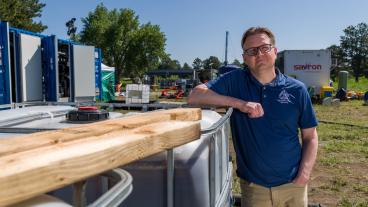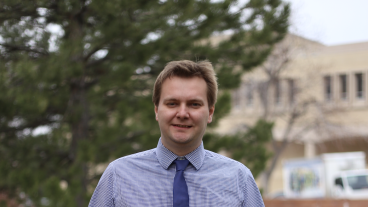Researchers at Colorado School of Mines have shown that protonic ceramic fuel cells can be used reversibly, both to efficiently generate electricity and to store that power in the form of chemical fuel at times of lower demand.
The breakthrough findings, “Highly efficient reversible protonic ceramic electrochemical cells for power generation and fuel production,” were published this past week in the journal Nature Energy.
“In this way, our reversible fuel cell device can act like a battery,” said Ryan O’Hayre, professor of metallurgical and materials engineering and co-lead author of the paper with postdoctoral researcher Chuancheng Duan PhD ‘18. “We can use our device to make hydrogen from water when there is excess renewable electricity on the grid that might otherwise go to waste. The hydrogen can be stored for later use or used in the chemical industry for various purposes. If we store some or all of the hydrogen, we can then also run our device in fuel cell mode using this stored hydrogen to produce electricity at times when there is not enough electricity available on the grid.”
The new findings, sponsored by the U.S. Department of Energy’s ARPA-E program, build on research published last year in the journal Nature. In the first long-term study of its kind, the Mines researchers showed that protonic ceramic fuel cells, a relatively new class of fuel cell technology, have both the long-term durability and fuel flexibility needed to become a viable commercial alternative to other existing technologies.
In that study, Duan and O’Hayre used 11 different fuels – hydrogen, methane, domestic natural gas (with and without hydrogen sulfide), propane, n-butane, i-butane, iso-octane, methanol, ethanol and ammonia – demonstrating excellent performance and exceptional durability across all types over thousands of hours of operation.
The new cells would also work in reverse as electrolyzers, efficiently breaking down water into hydrogen and oxygen.
“Hydrogen, if produced from renewable resources, is an environmentally friendly fuel because the only product after oxidation is water, which can be easily recycled,” said Duan, who will join the Department of Chemical Engineering at Kansas State University as an assistant professor in spring 2020. “Renewable hydrogen has the potential to help de-carbonize both the petrochemical industry and electricity generation and it could revolutionize the way we produce and store energy.”
Additionally, researchers showed, the device can be used to make methane instead of, or in addition to, hydrogen, if supplied with a combination of carbon dioxide and water.
“This technology offers opportunities for utilizing and storing carbon dioxide and thereby reduce carbon dioxide emissions,” O’Hayre said. “Methane has the added benefit of being easier to store and higher energy density than hydrogen. Additionally, this technology provides a pathway to manufacture methane fuel on Mars – for which NASA has shown keen interest – by utilizing the abundant carbon dioxide present on the red planet.”
Co-authors on the paper include Mines Mechanical Engineering Department faculty members Robert Kee, Huayang Zhu and Neal Sullivan; Colorado Center for Advanced Ceramics postdoctoral researcher Liangzhu Zhu; Liuzhen Bian, a visiting graduate student from University of Science & Technology Beijing; and Dylan Jennings, a PhD student in materials science.
“Through optimizing materials, we have presented high-performance protonic ceramic electrochemical cells for hydrogen production, CO2 utilization and sustainable fuels production,” Duan said. “These reversible fuel cells will play a key role in long-term energy storage for balancing a renewable energy integrated power grid.”
CONTACT
Emilie Rusch, Public Information Specialist, Communications and Marketing | 303-273-3361 | erusch@mines.edu
Mark Ramirez, Managing Editor, Communications and Marketing | 303-273-3088 | ramirez@mines.edu



